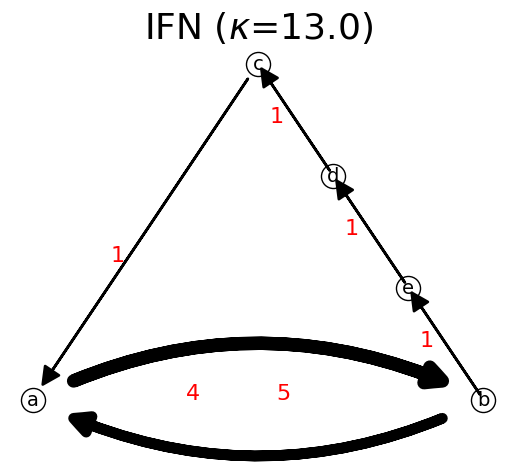IFN Tutorial for General Network
How to Install
You need to have Python installed. Go to Pypi.org and find IdealFlowNetwork version 1.15 (or latest version)
pip install IdealFlowNetwork
Alternatively, download the zip file from GitHub, unzip the file in a folder. 1. Go to folder pkg
cd your_folder_name
/pkg
In command Prompt >
pip install .
pip install .
It copies the package files to your Python environment. If you computer does not have pip, check ensurepip documentation
Using Ideal Flow Network
After the installation, to use IFN you need to import the module. To import, you can either use this style:
from IdealFlow import Network as net# from package import module as alias, or
or this style
import IdealFlow.Network as net# import package.module as alias
[1]:
# from IdealFlow import Network as net # from package import module as alias, or
import IdealFlow.Network as net # import package.module as alias
n = net.IFN()
print('IFN version:',n.version)
print('Copyright:',n.copyright)
IFN version: 1.15
Copyright: © 2018-2024 Kardi Teknomo
Notations
A = Adjacency matrix
B = Incidence matrix
C = Capacity matrix
F = Flow matrix
G = Congestion matrix
S = Stochastic matrix
sR = sum of rows
sC = sum of columns
kappa = \(\kappa\) = total flow in the nework
pi = \(\pi\) = node vector (steady state)
[m,n] = matrix size
Terminologies:
Path = trajectory = node sequence
Cycle = path that have the same start and end
Flow = link weight, or node weight
General Network
The IFN class can be used for a general network, not just for ideal flow types. Using the Ideal Flow Network (IFN), you can create any network (i.e., directed graph) by adding nodes or links.
Begin by adding links by specifying the from node, to node, and optionally, a link weight (flow). The default link weight is 1. When adding a link, the nodes are automatically added. By default, when a link is added, its flow is set to one (if not specified otherwise). You can also explicitly set the link flow by specifying the flow value.
n.add_link(startNode, endNode, linkFlow)
n.add_node(nodeName)
[2]:
n.add_link("a","b",2)
n.add_link("a","c",1)
n.add_link("a","d")
n.add_link("b","c")
n.add_link("b","e",3)
n.add_link("c","e",4)
n.add_link("d","c",5)
n.add_link("e","a",3)
Nodes are created automatically when you add a link. To add an isolated node, you can use
n.add_node(nodeName)
[3]:
n.add_node('isolated node')
We can show the network
n.show()
The total link flow, \(\kappa\), is shown in the network title when displaying the IFN.
The available layout options are: None, ‘Bipartite’, ‘Circular’, ‘Fruchterman’, ‘Kawai’, ‘Planar’, ‘Random’, ‘Shell’, ‘Spectral’, ‘Spiral’, and ‘Spring’.
[4]:
n.show();
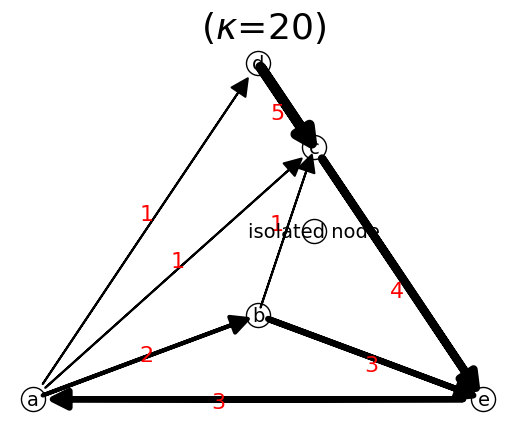
Deleting a node means deleting all the links connecting to that node.
n.delete_node(nodeName)
[5]:
n.delete_node("isolated node")
n.show();
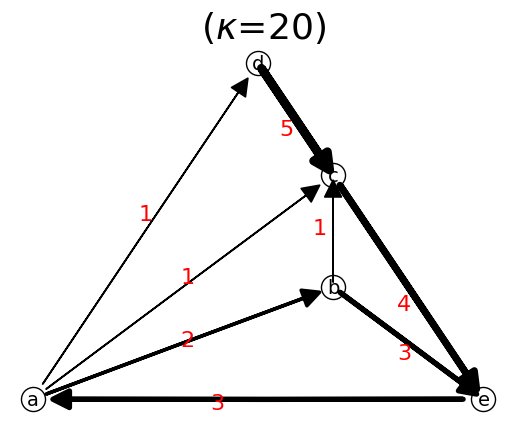
If we repeat add_link to the existing link, the link flow (i.e. link weight) will be added.
[6]:
n.add_link("a","d") # now link a->d has flow of 2
n.add_link("a","b",3) # now link a->b has flow of 5
n.show();
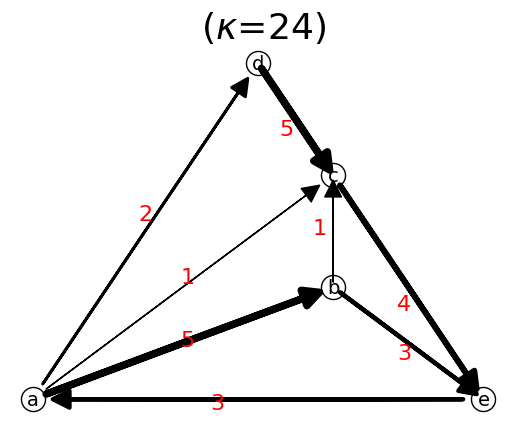
We can set the link weight directly via set_link_weight method.
n.set_link_weight(startNode, endNode, weight)
If you just want to add one flow, the following method simplify it.
n.set_link_weight_plus_1(startNode, endNode)
Alternatively, we can also set the link weight directly via set_item property:
n[startNode, endNode]=weight
[7]:
n["c","e"]=5
print(n["c","e"]) # prints 5
5
Link weight can be accessed via get_item of the network
n[startNode, endNode]
[8]:
n["c","e"]
[8]:
5
To delete a link by specifying the start and end nodes
n.delete_link(fromNode,toNode)
[9]:
n.delete_link("a","b")
n.show();
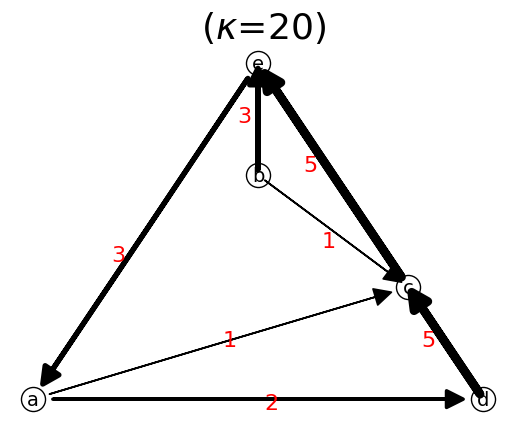
A network is reprsented by adjacency list or weighted adjacency matrix.
Printing the network would yield the adjacency list
print(n)
[10]:
print('adjacency list =\n',n)
adjacency list =
{'a': {'c': 1, 'd': 2}, 'b': {'c': 1, 'e': 3}, 'c': {'e': 5}, 'd': {'c': 5}, 'e': {'a': 3}}
We can also see the weighted adjacency matrix. The matrix is accompanied by the list of nodes in the same order as in the matrix.
matrix, list_node = n.get_matrix()
[11]:
F,list_node=n.get_matrix()
print('matrix =',F,'\n')
print('list of nodes =',list_node,'\n')
matrix = [[0, 0, 1, 2, 0], [0, 0, 1, 0, 3], [0, 0, 0, 0, 5], [0, 0, 5, 0, 0], [3, 0, 0, 0, 0]]
list of nodes = ['a', 'b', 'c', 'd', 'e']
To get the list nodes, use nodes property.
n.nodes
[12]:
print('nodes =',n.nodes,'\n')
nodes = ['a', 'b', 'c', 'd', 'e']
To get of dictionary of flows in each node, use nodes_flow property.
n.nodes_flow
[13]:
print('nodes =',n.nodes_flow,'\n')
nodes = {'a': 3, 'b': 4, 'c': 5, 'd': 5, 'e': 3}
The total number of nodes can be access via total_nodes property.
n.total_nodes
[14]:
n.total_nodes
[14]:
5
We list the links in the network via get_links property.
n.get_links
[15]:
n.get_links
[15]:
[['a', 'c'],
['a', 'd'],
['b', 'c'],
['b', 'e'],
['c', 'e'],
['d', 'c'],
['e', 'a']]
The total number of links ### Total Links
The total number of links can be access via total_links property.
n.total_links
[16]:
n.total_links
[16]:
7
We can reverse the direction of all links. The result is another network.
n.reverse_network()
[17]:
n = net.IFN()
n.add_link("a","b",1)
n.add_link("a","c",5)
n.add_link("a","d")
n.add_link("b","c")
n.add_link("b","e",3)
n.add_link("c","e",1)
n.add_link("d","c",5)
n.add_link("e","a",3)
nT=n.reverse_network()
n.show();
nT.show();
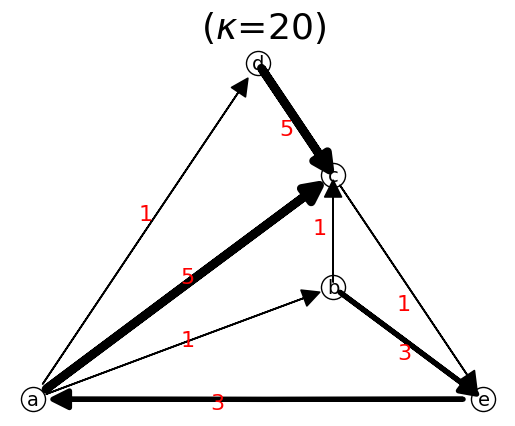
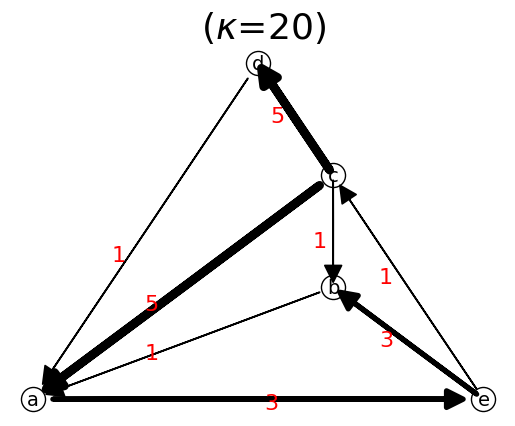
When we reverse the direction, the adjacency matrix is transposed.
[18]:
F0,nodes0=n.get_matrix()
print('original network\n',F0,'\n')
F1,nodes1=nT.get_matrix()
print('reverse network\n',F1)
original network
[[0, 1, 5, 1, 0], [0, 0, 1, 0, 3], [0, 0, 0, 0, 1], [0, 0, 5, 0, 0], [3, 0, 0, 0, 0]]
reverse network
[[0, 0, 0, 0, 3], [1, 0, 0, 0, 0], [5, 1, 0, 5, 0], [1, 0, 0, 0, 0], [0, 3, 1, 0, 0]]
Path
Find Path
Once we have define the network, we can get path from the network. Ths path is not necessarily the shortest path.
n.find_path(startNode, endNode)
[19]:
n.show();
print('path a->e =', n.find_path('a','e'),'\n')
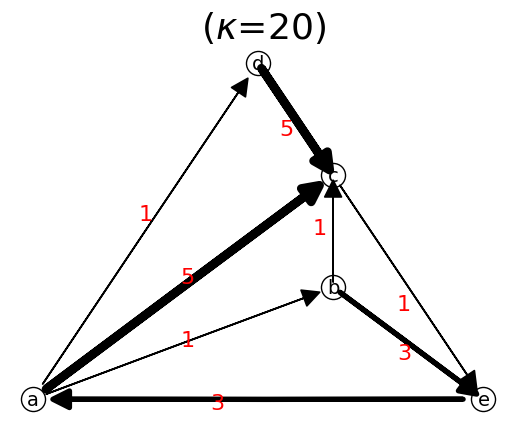
path a->e = ['a', 'b', 'c', 'e']
If path does not exist, it return empty list
[20]:
n.find_path('a','g')
[20]:
[]
We cannot find path to itself because it would just return itself.
[21]:
n.find_path('a','a')
[21]:
['a']
Find All Possible Paths
We can find all possible paths from a startNode to endNode
n.find_all_paths(startNode, endNode)
[22]:
print('all paths a->e =\n', n.find_all_paths('a','e'))
all paths a->e =
[['a', 'b', 'c', 'e'], ['a', 'b', 'e'], ['a', 'c', 'e'], ['a', 'd', 'c', 'e']]
Shortest Path
We can also get the shortest path. Shortest path is a path with minimum number of links. We can get the shortest path by shortest_path method
n.shortest_path(startNode, endNode)
[23]:
print('shortest path a->e =', n.shortest_path('a','e'),'\n')
shortest path a->e = ['a', 'b', 'e']
To get the total weights along the shortest path, we use
n.path_distance(startNode, endNode)
[24]:
n.path_distance('a','e')
[24]:
4
If we know the path as node sequence (i.e. trajectory) then we can also get the the total weights along the trajectory.
n.path_sum_weight(trajectory)
[25]:
n.path_sum_weight(['a', 'b', 'c','e'])
[25]:
3
All Shortest Path
We can find all shortest path matrix.
n.all_shortest_path()
all_shortest_path method produces a path matrix. The path matrix entries is the sum of link weights if there is a path and inf if no path exist.
[26]:
print('all shortest path:')
n.all_shortest_path()
all shortest path:
[26]:
([[6, 1, 2, 1, 3],
[5, 6, 1, 6, 2],
[4, 5, 6, 5, 1],
[9, 10, 5, 10, 6],
[3, 4, 5, 4, 6]],
['a', 'b', 'c', 'd', 'e'])
Testing Path
Testing if a trajectory (i.e. node sequence) is a path
n.is_path(trajectory)
[27]:
print('is a->b->d a path?',n.is_path(['a','b','d']),'\n')
is a->b->d a path? False
Set Path
Let us set that node sequence as a path in the network by expanding the network.
[28]:
n.set_path(['a','b','d'])
Now we can check if the same node sequence above is already a path.
[29]:
print('is a->b->d a path?',n.is_path(['a','b','d']),'\n')
n.show();
is a->b->d a path? True
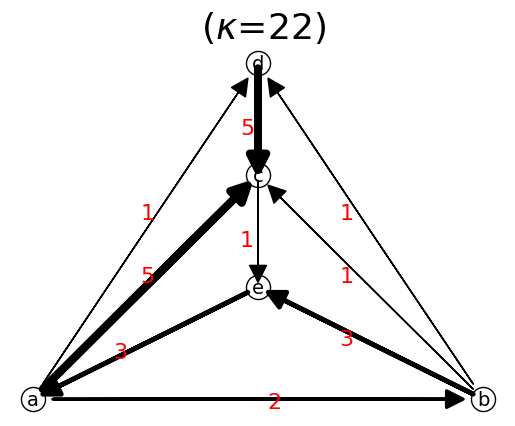
Network Properties
The example below we also shows network properties after we define the network.
[30]:
import IdealFlow.Network as net # import package.module as alias
n = net.IFN()
n.add_link("Beijing","New York",7)
n.add_link("New York","London",10)
n.add_link("London","Berlin",9)
n.add_link("New York","Toronto",8)
n.add_link("New York","Tokyo",1)
n.add_link("Tokyo","Berlin",5)
n.add_link("Tokyo","Beijing",11)
n.add_link("Beijing","Toronto",7)
n.add_link("Berlin","Beijing",5)
n.add_link("Toronto","Tokyo",15)
n.show("Circular");
# showing a few network properties
print('Network:', n) # string representation is an adjacency list
print('Total Nodes:',n.total_nodes) # number of nodes
print('Total Links:',n.total_links) # number of links
print('List of Links:',n.get_links) # list of links
print('List of Nodes:',n.nodes) # list of links
print('Total Flow:',n.total_flow) # total flow
print('Network Entropy:',n.network_entropy) # network entropy
print('Coef. Variantion of Flow:',n.cov_flow) # coef. variation of flow
print('Node Flow:',n.nodes_flow) # dictonary of {node name: sum of flow in node}
print("Link Flow from 'Tokyo' to 'Berlin' is",n.get_link_flow('Tokyo','Berlin')) # specific link flow from and to node
print("is_connected?",n.is_connected) # undirected connectivity test
print("is_strongly_connected?",n.is_strongly_connected) # directed connectivity test
print("is_premagic?",n.is_premagic) # balance of flow test
print('is ideal flow?',n.is_ideal_flow) # ideal flow test
n # network name
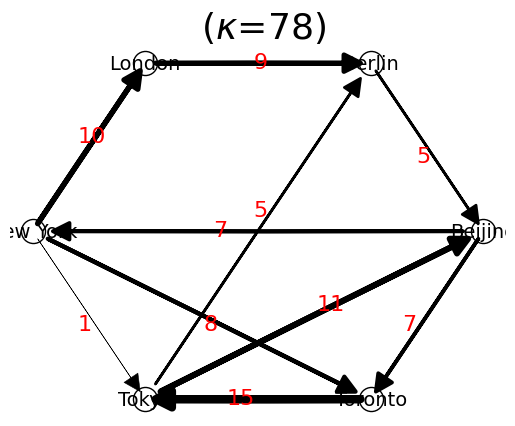
Network: {'Beijing': {'New York': 7, 'Toronto': 7}, 'New York': {'London': 10, 'Toronto': 8, 'Tokyo': 1}, 'London': {'Berlin': 9}, 'Berlin': {'Beijing': 5}, 'Toronto': {'Tokyo': 15}, 'Tokyo': {'Berlin': 5, 'Beijing': 11}}
Total Nodes: 6
Total Links: 10
List of Links: [['Beijing', 'New York'], ['Beijing', 'Toronto'], ['New York', 'London'], ['New York', 'Toronto'], ['New York', 'Tokyo'], ['London', 'Berlin'], ['Berlin', 'Beijing'], ['Toronto', 'Tokyo'], ['Tokyo', 'Berlin'], ['Tokyo', 'Beijing']]
List of Nodes: ['Beijing', 'Berlin', 'London', 'New York', 'Tokyo', 'Toronto']
Total Flow: 78
Network Entropy: 2.171231309893255
Coef. Variantion of Flow: 0.14707313230461527
Node Flow: {'Beijing': 14, 'New York': 19, 'London': 9, 'Berlin': 5, 'Toronto': 15, 'Tokyo': 16}
Link Flow from 'Tokyo' to 'Berlin' is 5
is_connected? True
is_strongly_connected? True
is_premagic? False
is ideal flow? False
[30]:
As an exercise, can you balance the flows in the network above such that the sum of inflows is equal to the sum of ouflows?
More Examples
Below are more several examples on how to create networks and showing its properties.
[31]:
# example of any network, not necessarily ideal flow
n = net.IFN("general network with self-loop and an isolated node")
n.add_link('a','b')
n.add_link('b','c', 3)
n.add_link('c','a')
n.add_link('c','e')
n.add_link('e','e',5) # we add self loop
n.add_node('d') # we add a node alone
n.show(); # show the network
# showing network properties
print('Network:', n) # string representation is an adjacency list
print('Total Nodes:',n.total_nodes) # number of nodes
print('Total Links:',n.total_links) # number of links
print('List of Links:',n.get_links) # list of links
print('List of Nodes:',n.nodes) # list of links
print('Total Flow:',n.total_flow) # total flow
print('Node Flow:',n.nodes_flow) # dictonary of {node name: sum of flow in node}
print('Link Flow from b to c is',n.get_link_flow('b','c')) # specific link flow from node 'b' to node 'c'
print("is_connected?",n.is_connected) # undirected connectivity test
print("is_strongly_connected?",n.is_strongly_connected) # directed connectivity test
print("is_premagic?",n.is_premagic) # balance of flow test
print('is ideal flow?',n.is_ideal_flow) # ideal flow test
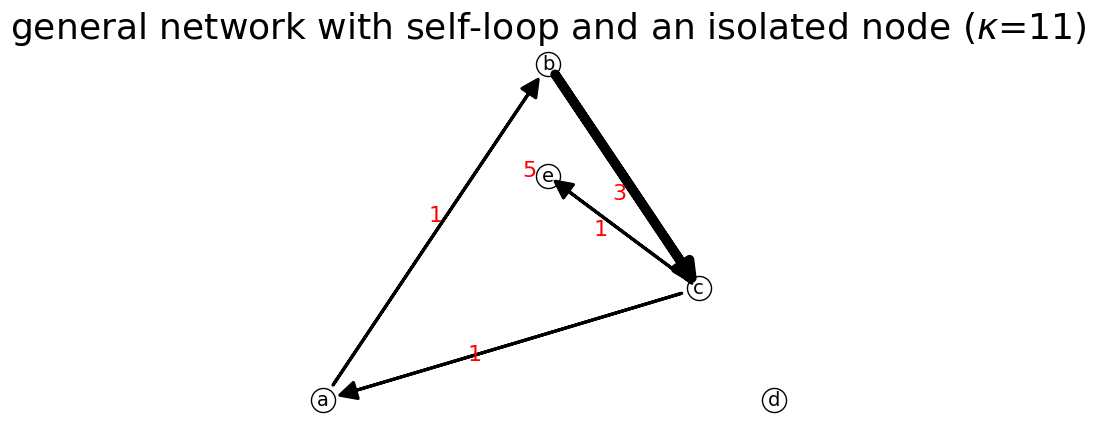
Network: {'a': {'b': 1}, 'b': {'c': 3}, 'c': {'a': 1, 'e': 1}, 'e': {'e': 5}, 'd': {}}
Total Nodes: 5
Total Links: 5
List of Links: [['a', 'b'], ['b', 'c'], ['c', 'a'], ['c', 'e'], ['e', 'e']]
List of Nodes: ['a', 'b', 'c', 'd', 'e']
Total Flow: 11
Node Flow: {'a': 1, 'b': 3, 'c': 2, 'e': 5, 'd': 0}
Link Flow from b to c is 3
is_connected? True
is_strongly_connected? False
is_premagic? False
is ideal flow? False
[32]:
n = net.IFN("Random Irreducible Network")
numNode=5 # number of nodes
numLink=numNode+int(3*numNode/4) # number of links
print("Design Total Nodes:",numNode,'\nDesign Total Links:',numLink)
# using static methods to generate matrix and test matrix
C=n.rand_irreducible(numNode,numLink) # generate random irreducible matrix
print("C=",C,'\n')
print('Is Irreducible:',n.is_irreducible_matrix(C)) # irreducibility test
listNodes=n.alphabet_list(numNode) # generate list of alphabetical node names, or
# listNodes=range(1,numNode+1) # generate list of numbers for node names
n.set_matrix(C,listNodes) # put the matrix into network
# showing network properties
print('Total Nodes:',n.total_nodes) # number of nodes
print('Total Links:',n.total_links) # number of links
print('List of Links:',n.get_links) # list of links
print('List of Nodes:',n.nodes) # list of links
print('totalFlow:',n.total_flow)
print('nodesFlow',n.nodes_flow)
n.show(layout="Fruchterman");
Design Total Nodes: 5
Design Total Links: 8
C= [[0 1 0 0 0]
[0 1 0 1 1]
[0 0 0 0 1]
[0 0 1 1 0]
[1 0 0 0 0]]
Is Irreducible: True
Total Nodes: 5
Total Links: 8
List of Links: [['a', 'b'], ['b', 'b'], ['b', 'd'], ['b', 'e'], ['c', 'e'], ['d', 'c'], ['d', 'd'], ['e', 'a']]
List of Nodes: ['a', 'b', 'c', 'd', 'e']
totalFlow: 8
nodesFlow {'a': np.int64(1), 'b': np.int64(3), 'c': np.int64(1), 'd': np.int64(2), 'e': np.int64(1)}
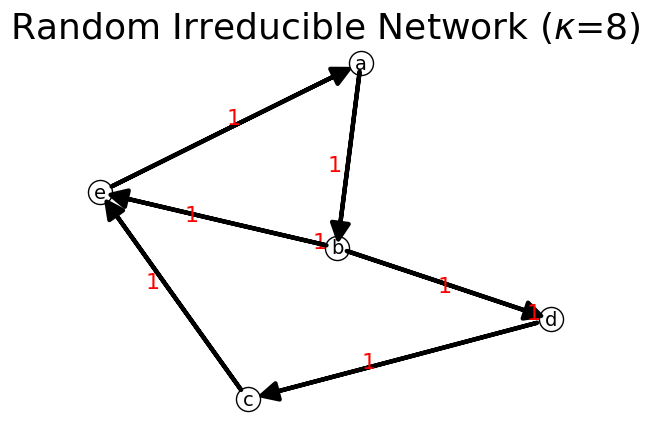
Example of generating capacity matrix
[33]:
# Example usage
from IdealFlow import Network as net
n = net.IFN("new example network")
k=9
m=k+int(3*k/4)
C=n.rand_irreducible(k,m) # k nodes, m links
print("C=",C,'\n')
C= [[0 0 0 0 0 1 0 0 1]
[0 0 1 1 0 0 0 0 0]
[1 0 0 0 0 0 0 0 0]
[0 0 1 0 0 0 0 0 0]
[0 0 1 0 0 0 0 0 1]
[0 0 1 0 1 0 0 0 0]
[0 1 0 0 0 0 1 0 0]
[0 0 0 0 0 0 1 0 0]
[1 0 0 0 0 0 0 1 0]]
Example below would generate a capacity matrix, and convert it into adjacency matrix, stochastic matrix and ideal flow matrix and finally scaling the IFN into an integer IFN.
[34]:
# another shorter way to access IFN
import IdealFlow.Network as net
n = net.IFN("random example network")
k=4
m=k+int(3*k/4)
C=n.rand_irreducible(k,m) # k nodes, m links
print("C=",C,'\n')
A=n.capacity_to_adjacency(C)
print("A=",A,'\n')
S=n.capacity_to_stochastic(C)
print("S=",S,'\n')
F=n.capacity_to_ideal_flow(C)
print("F=",F,'\n')
scaling=n.global_scaling(F,'int')
print('scaling:',scaling,'\n')
F1=n.equivalent_ifn(F, scaling)
F1
C= [[0 0 0 1]
[0 0 1 0]
[1 1 0 1]
[0 1 1 0]]
A= [[0 0 0 1]
[0 0 1 0]
[1 1 0 1]
[0 1 1 0]]
S= [[0. 0. 0. 1. ]
[0. 0. 1. 0. ]
[0.33333333 0.33333333 0. 0.33333333]
[0. 0.5 0.5 0. ]]
F= [[0. 0. 0. 0.125]
[0. 0. 0.25 0. ]
[0.125 0.125 0. 0.125]
[0. 0.125 0.125 0. ]]
scaling: 8
[34]:
array([[0., 0., 0., 1.],
[0., 0., 2., 0.],
[1., 1., 0., 1.],
[0., 1., 1., 0.]])
In the example below, we manually created the netwok by adding links. Then we get the capacity matrix and list nodes. We convert back the capacity matrix ino stochastic matrix. We convert stochastic matrix into markov node flows \(\pi\). Then we compute ideal flow matrix from the stochastic matrix and node flow vector. After that, we update the internal probability values before we show it. Then we defne a node sequence as a trajectory and get its path entropy. Based on the path entropy, we can find the match of ideal flow network name id. The last features is useful when you have many IFNs and would like to select which IFN match with the trajectory.
[35]:
import IdealFlow.Network as net
n = net.IFN("Test Network1")
print('n.name: ',n.name)
n.add_link("a","b",5)
n.add_link("b","c",1)
n.add_link("b","d",6)
n.add_link("c","e",1)
n.add_link("e","a",5)
n.add_link("e","b",2)
n.add_link("d","e",6)
print('adjacency list:',n)
print('is idealflow?',n.is_ideal_flow)
C,listNodes=n.get_matrix()
print('C',C)
print('listNodes',listNodes)
S=n.capacity_to_stochastic(C)
pi=n.markov(S)
print('pi:',pi)
F=n.ideal_flow(S, pi)
print('F:',F)
n.set_matrix(F,listNodes)
print('is idealflow?',n.is_ideal_flow)
print(n.network_prob)
n.network_probability # need to update network probability before output it
print(n.network_prob)
nodeSequence=["b","d","e","a","b"]
print("pathEntropy1",n.get_path_entropy(nodeSequence))
print(n.match(nodeSequence,{"abgh":n}),"\n")
print("net",n,"\n")
print("node values", n.nodes_flow)
print('max link flow=',n.max_flow)
n.name: Test Network1
adjacency list: {'a': {'b': 5}, 'b': {'c': 1, 'd': 6}, 'c': {'e': 1}, 'd': {'e': 6}, 'e': {'a': 5, 'b': 2}}
is idealflow? True
C [[0, 5, 0, 0, 0], [0, 0, 1, 6, 0], [0, 0, 0, 0, 1], [0, 0, 0, 0, 6], [5, 2, 0, 0, 0]]
listNodes ['a', 'b', 'c', 'd', 'e']
pi: [[0.19230769]
[0.26923077]
[0.03846154]
[0.23076923]
[0.26923077]]
F: [[0. 0.19230769 0. 0. 0. ]
[0. 0. 0.03846154 0.23076923 0. ]
[0. 0. 0. 0. 0.03846154]
[0. 0. 0. 0. 0.23076923]
[0.19230769 0.07692308 0. 0. 0. ]]
is idealflow? True
{}
{'a': {'b': np.float64(0.19230769230769218)}, 'b': {'c': np.float64(0.03846153846153843), 'd': np.float64(0.23076923076923062)}, 'c': {'e': np.float64(0.03846153846153836)}, 'd': {'e': np.float64(0.23076923076923095)}, 'e': {'a': np.float64(0.19230769230769254), 'b': np.float64(0.07692307692307701)}}
pathEntropy1 0.4727965657843897
('Test Network1', np.float64(1.0))
net {'a': {'b': np.float64(0.1923076923076921)}, 'b': {'c': np.float64(0.038461538461538415), 'd': np.float64(0.2307692307692305)}, 'c': {'e': np.float64(0.038461538461538346)}, 'd': {'e': np.float64(0.23076923076923084)}, 'e': {'a': np.float64(0.19230769230769246), 'b': np.float64(0.07692307692307698)}}
node values {'a': np.float64(0.1923076923076921), 'b': np.float64(0.26923076923076894), 'c': np.float64(0.038461538461538346), 'd': np.float64(0.23076923076923084), 'e': np.float64(0.26923076923076944)}
max link flow= 0.23076923076923084
In the network below, the initial network is an ideal flow, which is premagic and ireducible.
[36]:
# set up initial network
n = net.IFN("Initial Network")
n.add_link("a","b",5)
n.add_link("b","c",1)
n.add_link("b","d",6)
n.add_link("c","e",1)
n.add_link("e","a",5)
n.add_link("e","b",2)
n.add_link("d","e",6)
path = ["b","d","a","c","e"] # path of unlearn
n.show(routes=path,layout="Kawai");
print("is_connected?",n.is_connected) # undirected connectivity test
print("is_strongly_connected?",n.is_strongly_connected) # directed connectivity test
print("is_premagic?",n.is_premagic) # balance of flow test
print('is idealflow?',n.is_ideal_flow) # irreducible and premagic
n.network_probability # need to update network probability before output it
print('Network Probability: ',n.network_prob)
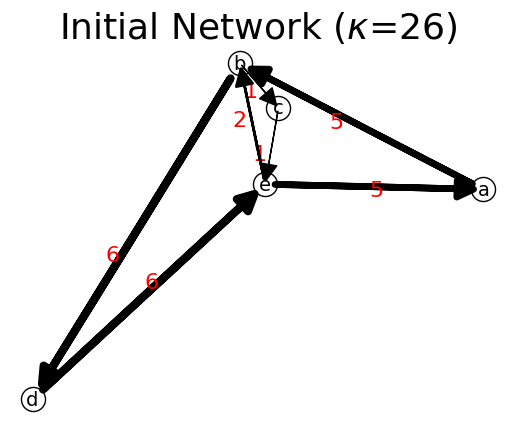
is_connected? True
is_strongly_connected? True
is_premagic? True
is idealflow? True
Network Probability: {'a': {'b': 0.19230769230769232}, 'b': {'c': 0.038461538461538464, 'd': 0.23076923076923078}, 'c': {'e': 0.038461538461538464}, 'd': {'e': 0.23076923076923078}, 'e': {'a': 0.19230769230769232, 'b': 0.07692307692307693}}
Then we set a path where the network is unlearned. It means along the path, the flow would be subtracted by one. When the flow is initially one, then the link that contains zero flow would be removed from the network. The result is weakly connected network with a sink node c.
[37]:
adjList = n.get_data() # get adjacency list of initial network
n1 = net.IFN("Network after Unlearned") # create new network
n1.set_data(adjList) # copy data from Initial Network
n1.unlearn(path) # unlearn
n1.show(layout="Spring");
print("is_connected?",n1.is_connected) # undirected connectivity test
print("is_strongly_connected?",n1.is_strongly_connected) # directed connectivity test
print("is_premagic?",n1.is_premagic) # balance of flow test
print('is idealflow?',n1.is_ideal_flow) # after unlearn, it is no longer ideal flow
print('is premagic network?',n1.is_premagic)
C,listNodes=n1.get_matrix()
print('is irreducible matrix?',n1.is_irreducible_matrix(C)) # not ideal flow because not irreducible
print('is premagic matrix?',n1.is_premagic_matrix(C))
print('is ideal flow matrix?',n1.is_ideal_flow_matrix(C))
n1.network_probability # need to update network probability before output it
print('Network Probability: ',n1.network_prob)
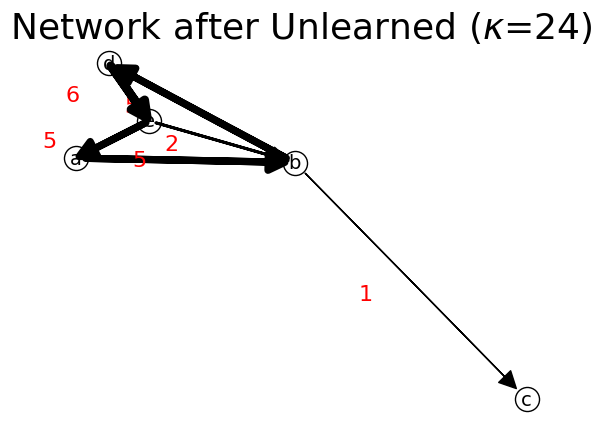
is_connected? True
is_strongly_connected? False
is_premagic? False
is idealflow? False
is premagic network? False
is irreducible matrix? False
is premagic matrix? False
is ideal flow matrix? False
Network Probability: {'a': {'b': 0.20833333333333331}, 'b': {'c': 0.041666666666666664, 'd': 0.20833333333333331}, 'd': {'e': 0.25}, 'e': {'a': 0.20833333333333331, 'b': 0.08333333333333333}}
The next code is to demonstrate that Weakly Connected Network cannot become IFN. Due to the existence of the sink node, the stochastic matrix contains zero row. The matrix is reducible. Therefore, it cannot be transformed into an ideal flow network.
[38]:
n2 = net.IFN("Network with Sink node cannot become IFN") # create new network
S=n2.capacity_to_stochastic(C)
print('S',S,'\n')
F=n2.stochastic_to_ideal_flow(S,100)
print('F=',F,'\n')
n2.set_matrix(F,listNodes)
n2.show(layout="Kawai");
print("is_connected?",n2.is_connected) # undirected connectivity test
print("is_strongly_connected?",n2.is_strongly_connected) # directed connectivity test
print("is_premagic?",n2.is_premagic) # balance of flow test
print('is idealflow?',n2.is_ideal_flow)
n2.network_probability # need to update network probability before output it
print('Network Probability: ',n2.network_prob)
S [[0. 1. 0. 0. 0. ]
[0. 0. 0.16666667 0.83333333 0. ]
[0. 0. 0. 0. 0. ]
[0. 0. 0. 0. 1. ]
[0.71428571 0.28571429 0. 0. 0. ]]
F= [[ 0. 19.04167548 0. 0. 0. ]
[ 0. 0. 4.54622382 22.7311191 0. ]
[ 0. 0. 0. 0. 0. ]
[ 0. 0. 0. 0. 23.93801565]
[17.92363021 7.16945208 0. 0. 0. ]]
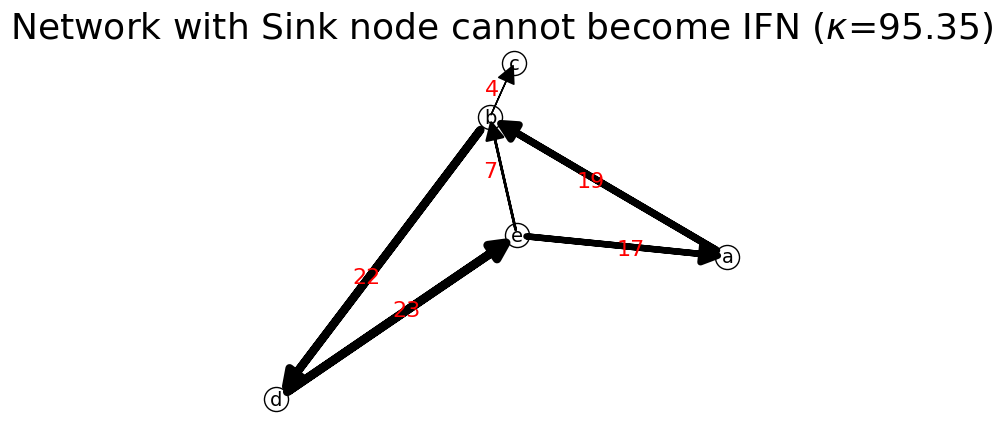
is_connected? True
is_strongly_connected? False
is_premagic? False
is idealflow? False
Network Probability: {'a': {'b': np.float64(0.19970269790557324)}, 'b': {'c': np.float64(0.04767926872559459), 'd': np.float64(0.23839634362797296)}, 'c': {}, 'd': {'e': np.float64(0.2510538693645723)}, 'e': {'a': np.float64(0.18797701455449065), 'b': np.float64(0.07519080582179624)}}
Network below contains source node c. Due to the existence of the source node , the stochastic matrix contains zero column. The matrix is reducible. Therefore, it cannot be transformed into an ideal flow network.
[39]:
n3 = net.IFN("Network with Source node cannot become IFN") # create new network
St=S.T
print('S.T',St,'\n')
F=n2.stochastic_to_ideal_flow(St,100)
print('F=',F,'\n')
n3.set_matrix(F,listNodes)
n3.show(layout=None);
print("is_connected?",n3.is_connected) # undirected connectivity test
print("is_strongly_connected?",n3.is_strongly_connected) # directed connectivity test
print("is_premagic?",n3.is_premagic) # balance of flow test
print('is idealflow?',n3.is_ideal_flow)
n3.network_probability # need to update network probability before output it
print('Network Probability: ',n3.network_prob)
S.T [[0. 0. 0. 0. 0.71428571]
[1. 0. 0. 0. 0.28571429]
[0. 0.16666667 0. 0. 0. ]
[0. 0.83333333 0. 0. 0. ]
[0. 0. 0. 1. 0. ]]
F= [[ 0. 0. 0. 0. 17.41491065]
[23.45557664 0. 0. 0. 6.70159333]
[ 0. 0.0461331 0. 0. 0. ]
[ 0. 22.08081013 0. 0. 0. ]
[ 0. 0. 0. 25.33441793 0. ]]
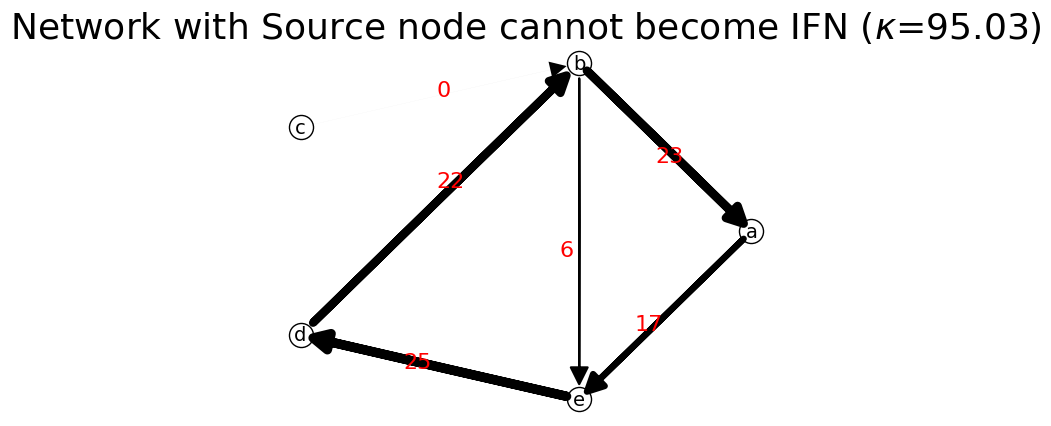
is_connected? True
is_strongly_connected? False
is_premagic? False
is idealflow? False
Network Probability: {'a': {'e': np.float64(0.1832503413653255)}, 'b': {'a': np.float64(0.24681392362927387), 'e': np.float64(0.07051826389407824)}, 'c': {'b': np.float64(0.0004854407405646304)}, 'd': {'b': np.float64(0.23234778956044813)}, 'e': {'d': np.float64(0.26658424081030957)}}
[40]:
n.show()
nodeSequence=["b","d","e","a","b","c","d"]
print("pathEntropy",n.get_path_entropy(nodeSequence))
print(n.match(nodeSequence,{"abgh":n}),"\n")
print("network:",n,"\n")
print("node values:", n.nodes_flow)
print('max link flow=',n.max_flow)
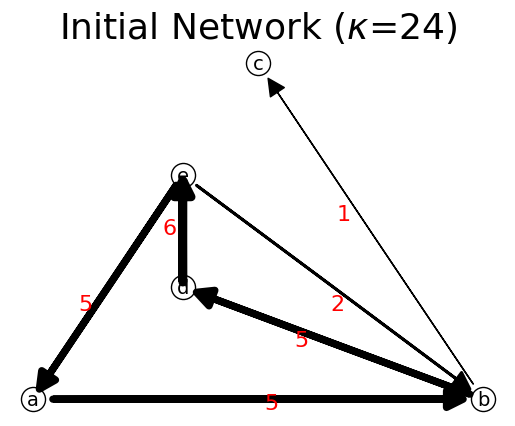
pathEntropy 0.34532873435716427
('Initial Network', 1.0)
network: {'a': {'b': 5}, 'b': {'c': 1, 'd': 5}, 'd': {'e': 6}, 'e': {'a': 5, 'b': 2}}
node values: {'a': 5, 'b': 6, 'd': 6, 'e': 7}
max link flow= 6
Now let us create a random irreducible network and do some testings
[41]:
n = net.IFN("Capacity") # create new network
k=5 # number of nodes
m=k+int(3*k/4) # number of links
C=n.rand_irreducible(k,m) # generate random irreducible matrix
print("C:",C,"\n")
print('is irreducible matrix?',n.is_irreducible_matrix(C)) # not ideal flow because not irreducible
print('is premagic matrix?',n.is_premagic_matrix(C))
print('is ideal flow matrix?',n.is_ideal_flow_matrix(C))
n.set_matrix(C)
print("is_connected?",n.is_connected) # undirected connectivity test
print("is_strongly_connected?",n.is_strongly_connected) # directed connectivity test
print("is_premagic?",n.is_premagic) # balance of flow test
print('is ideal flow?',n.is_ideal_flow) # ideal flow test
print(n)
n.show();
C: [[0 1 0 0 0]
[1 0 1 0 0]
[0 0 0 0 1]
[1 1 0 0 0]
[0 1 0 1 0]]
is irreducible matrix? True
is premagic matrix? False
is ideal flow matrix? False
is_connected? True
is_strongly_connected? True
is_premagic? False
is ideal flow? False
{'a': {'b': np.int64(1)}, 'b': {'a': np.int64(1), 'c': np.int64(1)}, 'c': {'e': np.int64(1)}, 'd': {'a': np.int64(1), 'b': np.int64(1)}, 'e': {'b': np.int64(1), 'd': np.int64(1)}}
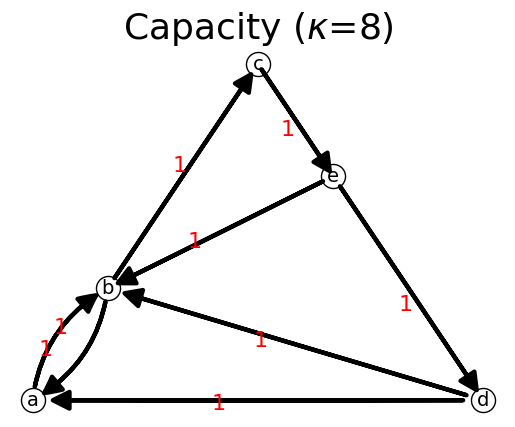
Let us create a new network that would balance the flow in each nodes such that the sum of inflows would be equal to the sum of outflows.
[42]:
n = net.IFN("IFN") # create new network
F1=n.capacity_to_ideal_flow(C,1)
scaling= n.global_scaling(F1,'int')
F=n.equivalent_ifn(F1,scaling)
print("F:",F,"\n")
print('is irreducible matrix?',n.is_irreducible_matrix(F)) # not ideal flow because not irreducible
print('is premagic matrix?',n.is_premagic_matrix(F))
print('is ideal flow matrix?',n.is_ideal_flow_matrix(F))
F: [[0. 5. 0. 0. 0.]
[4. 0. 4. 0. 0.]
[0. 0. 0. 0. 4.]
[1. 1. 0. 0. 0.]
[0. 2. 0. 2. 0.]]
is irreducible matrix? True
is premagic matrix? True
is ideal flow matrix? True
Ideal Flow Network
Having a network does not mean it is Ideal Flow Network (IFN)
[43]:
n = net.IFN("IFN") # create new network
C=n.rand_capacity()
print('C:',C)
F1=n.capacity_to_ideal_flow(C,1)
scaling= n.global_scaling(F1,'min',1)
F=n.equivalent_ifn(F1,scaling)
print('F:',F)
n.set_matrix(F,['a','b','c','d','e'])
n.show();
C: [[0 1 0 0 0]
[8 0 0 0 2]
[3 0 0 0 0]
[0 0 6 0 0]
[0 0 0 4 0]]
F: [[0. 5. 0. 0. 0.]
[4. 0. 0. 0. 1.]
[1. 0. 0. 0. 0.]
[0. 0. 1. 0. 0.]
[0. 0. 0. 1. 0.]]
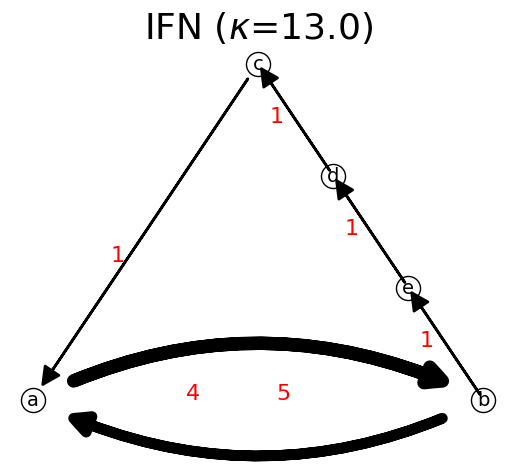
Let us do it step by step.
First, let us test if the network is an ideal flow network
[44]:
print('is Ideal Flow?',n.is_ideal_flow,'\n')
is Ideal Flow? True
An ideal flow network must be both strongly connected and premagic. Let us test whether it is strongly connected
[45]:
print('is strongly connected?',n.is_strongly_connected,'\n')
is strongly connected? True
Let us test if the flows are balance in each node
[46]:
print('is premagic?',n.is_premagic,'\n')
is premagic? True
To make strongly connected network into ideal flow network, first, let us assume the existing weight as capacity matrix
[47]:
C,list_node=n.get_matrix()
print('list_node:',list_node)
C
list_node: ['a', 'b', 'c', 'd', 'e']
[47]:
[[0, np.float64(5.000000000000002), 0, 0, 0],
[np.float64(4.0), 0, 0, 0, np.float64(1.0)],
[np.float64(1.0000000000000013), 0, 0, 0, 0],
[0, 0, np.float64(1.0000000000000042), 0, 0],
[0, 0, 0, np.float64(1.0000000000000018), 0]]
Then we compute the ideal flow and scale it to integer
[48]:
F1=n.capacity_to_ideal_flow(C)
scaling= n.global_scaling(F1,'min',1)
F=n.equivalent_ifn(F1,scaling)
print('F =',F,'\n')
F = [[0. 5. 0. 0. 0.]
[4. 0. 0. 0. 1.]
[1. 0. 0. 0. 0.]
[0. 0. 1. 0. 0.]
[0. 0. 0. 1. 0.]]
We replace the adjacency list of the network with the ideal flow matrix F. we can see the flow is in equilibrium such that total inflow is equal total outflow in each node.
[49]:
n.set_matrix(F,list_node)
print('is Ideal Flow?',n.is_ideal_flow,'\n')
n.show();
is Ideal Flow? True
